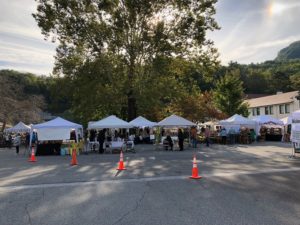 The internet paints Highlands as a town known more for its iconic waterfalls than its community. Driving on the winding roads of Highway 64 to Highlands, I was expecting a shambly town with a couple shops on main street. The ride there was full of leaves on the verge of changing, unexpected turns, and waterfalls I couldn’t fully take in as the driver.
The internet paints Highlands as a town known more for its iconic waterfalls than its community. Driving on the winding roads of Highway 64 to Highlands, I was expecting a shambly town with a couple shops on main street. The ride there was full of leaves on the verge of changing, unexpected turns, and waterfalls I couldn’t fully take in as the driver.
As we approached Highlands, the road straightened. The gorges, waterfalls, and endless forests on either side of the ro
ad evaporated, replaced by a sign welcoming us to the Highlands and a man-made lake surrounded by vacation homes. The blue waters and the lake houses took my breath away. The last thing I was expecting to find in the North Carolina mountains was a vacationing community similar to the small vacioning towns on the shores of the Great Lakes in Michigan and Wisconsin.
The housing community disappeared, replaced by a quiet mainstreet lined with artisanal shops and small diners with outdoor seating. The streets were lined with parking spots, enough to support a mirage of tourists, yet at 8am on a Saturday, the majority were empty. I easily found a parking spot and parked the car.
My group explored the sleeping downtown. Each shop was designed to create a cohesive wooden, yet elegant feel. Stores advertised artisanal chocolate and pottery in intricate cursive on their windows. A layer of fog settled over the town, highlighting the ornate churches founded in the 1800s and the way the ivy sprung up on the brick buildings, such as the Old Edward’s Inn. This was the type of town one found in Hallmark movies, as unbelievable as it was cosy.
As the day unfolded, the little town came to life. Around 10am, some of the parking spots began to fill with vintage cars. Remembering how my dad used to take me to car shows growing up, I walked up to the men standing near the cars and asked, “Is there a car show here today?”
“No.” The man looked over at the row of polished cars from the 20th century. “We just come here every Saturday to show off our cars and socialize. It’s called Butts on the Benches.”
Butts on the Benches is an event started by a community of older men who retired to the Highlands back in 2012. The originator, Allan, died in 2016 and the bench in front of the cars was donated in his honor, a plaque signifying his creation of the group.
Butts on the Benches served as a time of community, laughter, and relaxation for these men. They talked of their passion for cars and their community. Yet, despite their love for the Highlands, not a single one was a native. They all came from Atlanta, Miami, Orlando, or another Southern city after retirement. Most weren’t even from North Carolina.
Later in the day, we found ourselves at the Highlands Antique Shop. Two buildings full of antiques that Stephanie loved exploring. The shop contained China plates with a history older than mine and tattered, well-read books and all proceeds support local charities.
Yet, it wasn’t the objects that intrigued me, but the history of Highlands. Highlands was a bustling yet tranquil center of commerce, a town designed for both tourists and retirees looking for a mindful, nature-centered lifestyle.
I talked to the lady who worked at the shop, Ann, on why she decided to move to the Highlands. She told me she had been climbing the corporate ladder in Atlanta, along with her husband. One day, they got tired of the fast pace life of Atlanta, decided to retire, and settled into the Highlands, where she volunteered to run the antique shop. While she mentioned that tourism had increased in the last ten years, this year having the highest traffic of year-round visitors, she loved Highlands because it might not have been where she lived the longest, but it felt like home. The relaxed, easy way of life had brought Ann peace.
At the end of our conversation, she warned me against living in Atlanta or getting caught up in status, money, or prestige. “Living in Highlands has taught me what’s important in life and I’m glad more young people like yourself are touring the town. I hope you walk away knowing what’s important–simple living, community, and giving back.”
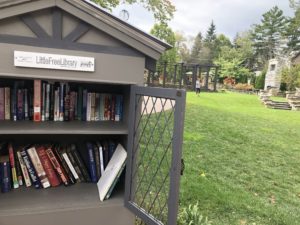
While Highlands might not be a sprawling metropolis or even a classic Southern small town, it serves as an important reminder in a world obsessed with speed and technology.
Amongst daily life, it’s important to remember what matters most–community and simplicity. Highlands serves not only as a place of retirement for people from all over the United States, but a reminder that home isn’t where you’ve lived the longest. Home is where you’ve found happiness and gained a greater appreciation for the small charms of life.
Highlands has redefined home and what’s important for people from all over the nation. The town’s citizens hope everyone who steps into the Highlands are impacted by this lesson, even people like our travel team who stop by just for a day.
Written by: Angela Myers




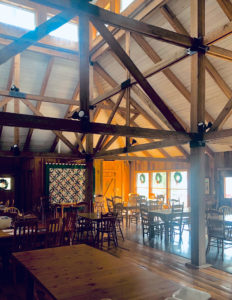

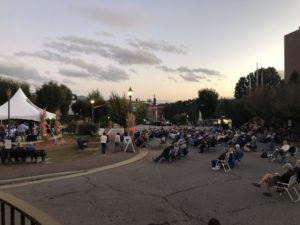
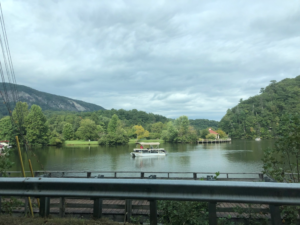
 The internet paints Highlands as a town known more for its iconic waterfalls than its community. Driving on the winding roads of Highway 64 to Highlands, I was expecting a shambly town with a couple shops on main street. The ride there was full of leaves on the verge of changing, unexpected turns, and waterfalls I couldn’t fully take in as the driver.
The internet paints Highlands as a town known more for its iconic waterfalls than its community. Driving on the winding roads of Highway 64 to Highlands, I was expecting a shambly town with a couple shops on main street. The ride there was full of leaves on the verge of changing, unexpected turns, and waterfalls I couldn’t fully take in as the driver.
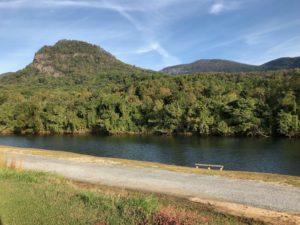 Along the winding road of Highway 64 lies Lake Lure. This small town is known for its parks, historic landmarks, and, as denoted by its name, winding lake. Lake Lure is not vast in size, with a population just shy of 2,000 people, but it’s landmarks cannot be missed during a journey down Highway 64. When traveling from the west, you will first stumble upon the grand entrance to Chimney Rock State Park. A quick turn in will lead you through a tree lined climb up to the state park entrance. The road, which is surprisingly wide enough to fit two-way traffic, is a difficult drive. However, the clearing at the top that houses the Chimney Rock entrance is a welcome surprise. The entrance is home to a guardhouse that must be passed through before being admitted into the park. While waiting in line to speak with the park guard, the view is incredible. You can see Chimney Rock and the hike up along with a beautiful blue sky and autumn leaves if you, like us, visit on a clear October morning. Be advised, however, that admission into the park is not without cost. At a rate of $13 per adult and $6 per child, tickets to this unique experience can be purchased both online and at the park entrance gate. This seemingly steep admission cost caught us by surprise. As a result, we turned around and braved the treacherous drive once over to see what else Lake Lure had to offer.
Along the winding road of Highway 64 lies Lake Lure. This small town is known for its parks, historic landmarks, and, as denoted by its name, winding lake. Lake Lure is not vast in size, with a population just shy of 2,000 people, but it’s landmarks cannot be missed during a journey down Highway 64. When traveling from the west, you will first stumble upon the grand entrance to Chimney Rock State Park. A quick turn in will lead you through a tree lined climb up to the state park entrance. The road, which is surprisingly wide enough to fit two-way traffic, is a difficult drive. However, the clearing at the top that houses the Chimney Rock entrance is a welcome surprise. The entrance is home to a guardhouse that must be passed through before being admitted into the park. While waiting in line to speak with the park guard, the view is incredible. You can see Chimney Rock and the hike up along with a beautiful blue sky and autumn leaves if you, like us, visit on a clear October morning. Be advised, however, that admission into the park is not without cost. At a rate of $13 per adult and $6 per child, tickets to this unique experience can be purchased both online and at the park entrance gate. This seemingly steep admission cost caught us by surprise. As a result, we turned around and braved the treacherous drive once over to see what else Lake Lure had to offer.